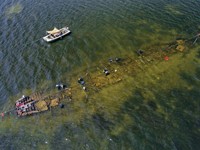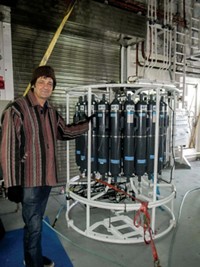Advertisement
Grab your lab coat. Let's get started
Welcome!
Welcome!
Create an account below to get 6 C&EN articles per month, receive newsletters and more - all free.
It seems this is your first time logging in online. Please enter the following information to continue.
As an ACS member you automatically get access to this site. All we need is few more details to create your reading experience.
Not you? Sign in with a different account.
Not you? Sign in with a different account.
ERROR 1
ERROR 1
ERROR 2
ERROR 2
ERROR 2
ERROR 2
ERROR 2
Password and Confirm password must match.
If you have an ACS member number, please enter it here so we can link this account to your membership. (optional)
ERROR 2
ACS values your privacy. By submitting your information, you are gaining access to C&EN and subscribing to our weekly newsletter. We use the information you provide to make your reading experience better, and we will never sell your data to third party members.
Chemical Sensing
Underwater device measures reactive superoxides near corals
A new handheld instrument can measure chemical species suspected in causing coral bleaching
by Lakshmi Supriya, special to C&EN
November 19, 2019

Reactive chemical species are not easy to measure in the lab or on land, as they are notoriously short-lived. When these species are underwater, the challenges multiply. A new device, which can be operated underwater, measures reactive oxygen species around corals without the need to bring the seawater to the surface (Environ. Sci. Technol. 2019, DOI: 10.1021/acs.est.9b04022). This makes it easier to study ocean chemistry and may allow scientists to better understand the ocean’s chemical processes.
One such process is the production of superoxide (O∙2-) around corals. When corals are stressed by heat or light, they produce more superoxide inside their cells, banishing the algae they depend on, which can lead to coral death. Different pathways—in some cases using coral-derived enzymes—also produce superoxide outside the corals, which, on the other hand, protects them from disease and stress. Although superoxide is a suspect in causing bleaching and death of corals, there is no conclusive evidence, and the link is rather tenuous. The lack of direct measurements of superoxide around corals only adds to the uncertainty. “Superoxide is a ‘Jekyll and Hyde’ molecule,” says study coauthor Colleen Hansel of the Woods Hole Oceanographic Institution. “It is both essential and detrimental for life.”
Previously, Hansel and her team measured coral superoxides by collecting water samples and analyzing them with a device on a boat (Nat. Commun. 2016, DOI: 10.1038/ncomms13801). But since superoxides live only for about 30 s, they were difficult to measure beyond 2 m depth, because of the time it took to bring the water samples to the surface. The device needed a team of snorkelers and instrument operators to make measurements. In addition, the device had to be free from any vibrations, which required operating in calm waters.
Hansel and her team wanted a device they could take into the water to measure deeper reefs. So they designed a new instrument—the size of a small suitcase—with off-the-shelf parts like pumps, flow cells, and photomultiplier tubes and developed a data visualization interface and controls. “The main challenges have been finding components that are completely inert,” Hansel says. Superoxide is very reactive and decays as soon as it contacts materials such as metals and organic matter. In addition, the team had to eliminate leaks, minimize sample flow time before measurement, and adjust the device’s density to match seawater so that researchers could easily dive with it.
“Now with the new submersible device, it only takes one person, a diver, to make the same measurements, and the new device can also reach sites that were previously inaccessible to the old instrument,” says Julia M. Diaz, a biogeochemist at the Scripps Institution of Oceanography. Diaz worked on the older boat-based model but was not involved in the development of the new device.
Like the older surface model, the new device detected superoxide with a widely used chemiluminescent probe, a luciferin analog from a marine organism (Cypridina). To calibrate the device, the researchers tested standard solutions and filtered seawater to link the chemiluminescence intensity with superoxide concentration. The team determined the presence of superoxide with an assay involving an enzyme, superoxide dismutase, which quickly degrades superoxide into hydrogen peroxide and molecular oxygen.
The team first tested the device in the waters off Woods Hole, Massachusetts. The researchers then took the device to coral reefs off Cuba’s coast for field testing, where they looked at 27 colonies of seven different coral species, diving 14 m underwater.
The authors found that different species of corals emit different amounts of superoxides. “So clearly they are regulating its production, and it’s species specific,” Hansel says. “We don’t know why yet.” The coral type Porites, which is known to be very hardy, produced the largest amount of superoxide. Superoxides could be playing a role in its resilience, Hansel thinks. Understanding superoxide chemistry may ultimately improve management strategies for corals, which are severely threatened by climate change and disease.





Join the conversation
Contact the reporter
Submit a Letter to the Editor for publication
Engage with us on Twitter